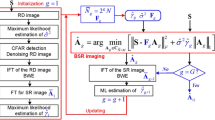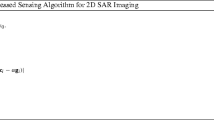Abstract
Sparse signal processing is a signal processing technique that takes advantage of signal’s sparsity, allowing signal to be recovered with a reduced number of samples. Compressive sensing, a new branch of the sparse signal processing, has become a rapidly growing research field. Sparse microwave imaging introduces the sparse signal processing theory to radar imaging to obtain new theories, new systems and new methodologies of microwave imaging. This paper first summarizes the latest application of sparse microwave imaging, including Synthetic Aperture Radar (SAR), tomographic SAR and inverse SAR. As sparse signal processing keeps evolving, an avalanche of results have been obtained. We also highlight its recent theoretical advances, including structured sparsity, off-grid, Bayesian approaches, and point out new research directions in sparse microwave imaging.
Similar content being viewed by others
References
Elad M. Sparse and redundant representations: from theory to applications in signal and image processing. New York, NY: Springer, 2010
Yonina C. Compressed Sensing: Theory and Applications. In: Eldar Y, Kutyniok G, ed. Cambridge University Press, 2012
Zhang B C, Hong W, Wu Y. R. Sparse microwave imaging: principles and applications. Sci China Inf Sci, 2012, 55(8): 1722–1754
Baraniuk R, Steeghs P. Compressive radar imaging. In: Proc of IEEE Radar Conference, Boston, 2007. 128–133
Patel V M, Easley G R, Healy D, et al. Compressed synthetic aperture radar. IEEE J Sel Top Signal Process, 2010, 4(2): 244–254
Ender J H G. On compressive sensing applied to radar. Signal Process, 2010, 90(5): 1402–1414
Jiang C L, Zhang B C, Zhang Z, et al. Experimental results and analysis of sparse microwave imaging from spaceborne radar raw data. Sci China Inf Sci, 2012, 55(8): 1801–1815
Stojanovic I, Cetin M, Karl W C. Compressed sensing of monostatic and multistatic SAR. IEEE Geosci Remote Sens Lett, 2013, 10(6): 1444–1448
Sun J P, Zhang Y X, Tian J H, et al. A novel spaceborne SAR wide-swath imaging approach based on Poisson disk-like nonuniform sampling and compressive sensing. Sci China Inf Sci, 2012, 55(8): 1876–1887
Xu H P, You Y N, Li C S, et al. Spotlight SAR sparse sampling and imaging method based on compressive sensing. Sci China Inf Sci, 2012, 55(8): 1816–1829
Zeng C, Wang M H, Liao G S, et al. Sparse synthetic aperture radar imaging with optimized azimuthal aperture. Sci China Inf Sci, 2012, 55(8): 1852–1859
Shastry M C, Narayanan R M, Rangaswamy M. Compressive radar imaging using white stochastic waveforms. In: Proceeding of International Waveform Diversity and Design Conference (WDD), Niagara Falls, 2010. 90–94
Yang J, Thompson J, Huang X, et al. Random-frequency SAR imaging based on compressed sensing. IEEE Trans Geosci Remote Sens, 2013. 51(2): 983–994
Fang J, Xu Z B, Zhang B C, et al. Fast compressed sensing SAR imaging based on approximated observation. IEEE J Sel Topics Appl Earth Observ Remote Sens, accepted
Yang J, Thompson J, Huang X, et al. Segmented reconstruction for compressed sensing SAR imaging. IEEE Trans Geosci Remote Sens, 2013. 51(7): 4214–4225
Fang J, Zeng J S, Xu Z B, et al. Efficient DPCA SAR imaging with fast iterative spectrum reconstruction method. Sci China Inf Sci, 2012, 55(8): 1838–1851
Zhu X X, Bamler R. Tomographic SAR inversion by L1-Norm regularization — The compressive sensing approach. IEEE Trans Geosci Remote Sens, 2010, 48(10): 3839–3846
Aguilera E, Nannini M, Reigber A. A data-adaptive compressed sensing approach to polarimetric SAR tomography of forested areas. IEEE Geosci Remote Sens Lett, 2013, 10(3): 543–547
Zhu X X, Bamler R. Let’s do the time warp: multicomponent nonlinear motion estimation in differential SAR tomography. IEEE Geosci Remote Sens Lett, 2011, 8(4): 735–739
Zhu X X, Bamler R. Super-resolution power and robustness of compressive sensing for spectral estimation with application to spaceborne tomographic SAR. IEEE Trans Geosci Remote Sens, 2012, 50(1): 247–258
Aguilera E, Nannini M, Reigber A. Multisignal compressed sensing for polarimetric SAR tomography. IEEE Geosci Remote Sens Lett, 2013, 9(5): 871–875
Zhu F, Zhang Q, Luo Y, et al. A novel cognitive ISAR imaging method with random stepped frequency chirp signal. Sci China Inf Sci, 2012, 55(8): 1910–1924
Giusti E, Tomei S, Bacci A, et al. Autofocus for CS based ISAR imaging in the presence of Gapped Data. In: 2nd International Workshop on Compressed Sensing Applied to Radar (CoSeRa), 2013
Ugur S, Arikan O, Gubuz A. Autofocused sparse SAR image reconstruction by EMMP algorithm. In: 1st International Workshop on Compressed sensing Applied to Radar (CoSeRa), 2012
Yu X, Rao W, Li G, et al. ISAR motion compensation via parametric compressed sensing. In: IEEE Radar Conference, 2013. 1–4
Ender J H G. A brief review of compressive sensing applied to radar. In: 14th International Radar Symposium (IRS), 2013. 3–16
Zhang L, Xing M D, Qiu C W, et al. Resolution enhancement for inversed synthetic aperture radar imaging under low SNR via improved compressive sensing. IEEE Trans Geosci Remote Sens, 2010, 48(10): 3824–3838
Strohmer T. Measure what should be measured: progress and challenges in compressive sensing. IEEE Signal Process Lett, 2012, 19(12): 887–893
Elad M. Sparse and redundant representation modeling — what next? IEEE Signal Process Lett, 2012, 19(12): 922–928
Huang J, Zhang T. The benefit of group sparsity. The Annals Statis, 2010, 38(4): 1978–2004
Yu G, Sapiro G, Mallat S. Solving inverse problems with piecewise linear estimators: from Gaussian mixture models to structured sparsity. IEEE Trans Image Process, 2012, 21(5): 2481–2499
Daudet L. Sparse and structured decomposition of audio signals in overcomplete spaces. In: International Conference on Digital Audio Effects, 2004. 1–5
Baraniuk R G, Cevher V, Duarte M F, et al. Model-based compressive sensing. IEEE Trans Inform Theory, 2010, 56(4): 1982–2001
Zhang B C, Jiang C L, Zhang Z, et al. Azimuth ambiguity suppression for SAR imaging based on group sparse reconstruction. In: 2nd International Workshop on Compressed sensing applied to radar (CoSeRa), 2013
Petropulu A P, Yu Y, Huang J. On exploring sparsity in widely separated MIMO radar. In: 5th IEEE Signals, Systems and Computers Conference(ASILOMAR), 2011. 1496–1500
Gretsistas A, Plumbley M D. A source localization approach based on structured sparsity for broadband far-field sources. In: Proc 4th Workshop on Signal Processing with Adaptive Sparse Structured Representations (SPARS), Edinburgh, 2011. 35
Leigsnering M, Ahmad F, Amin M. General MIMO Framework for multipath exploitation in through the wall radar imaging. In: 2nd International Workshop on Compressed sensing applied to radar (Co-SeRa), 2013
Herman M A, Strohmer T. High-resolution radar via compressed sensing. IEEE Trans Signal Process, 2009, 57(6): 2275–2284
Fannjiang A, Liao W. Mismatch and resolution in compressive imaging. In: Proc SPIE, 2011. 81380Y–81380Y
Tang G, Bhaskar B N, Shah P, et al. Compressed sensing off the grid. arXiv:1207.6053. 2012
Fannjiang A, Tseng H C. Compressive radar with off-grid and extended targets. arXiv:1209.6399. 2012
Romer F, Alieiev R, Ibrahim M, et al. An analytical study of sparse recovery algorithms in presence of an off-grid source. In: 2nd International Workshop on Compressed Sensing Applied to Radar (Co-SeRa), 2013
Minner M. Off-Grid compressive sensing MIMO radar. In: 2nd International Workshop on Compressed Sensing Applied to Radar (CoSeRa), 2013
Prünte L. Off-Grid compressed sensing for GMTI using SAR images. In: 2nd International Workshop on Compressed Sensing Applied to Radar (CoSeRa), 2013
Teke O, Gurbuz A, Arikan O. Sparse delay-doppler image reconstruction under off-grid problem. In: 2nd International Workshop on Compressed Sensing Applied to Radar (CoSeRa), 2013
Ji S H, Ya X, Lawrence C. Bayesian compressive sensing. IEEE Trans Signal Process, 2008, 56(6): 2346–2356
Derin B S, Molina R, Katsaggelos A K. Bayesian compressive sensing using Laplace priors. IEEE Trans Image Process, 2010, 19(1): 53–63
Donoho D L, Maleki A, Montanari A. Message passing algorithms for compressed sensing: I. motivation and construction. In: IEEE Information Theory Workshop (ITW), 2010
Donoho D L, Maleki A, Montanari A. Message passing algorithms for compressed sensing: II. analysis and validation. In: IEEE Proceedings of Information Theory Workshop (ITW), 2010
Xu G, Xing M D, Zhang L. Bayesian inverse synthetic aperture radar imaging. IEEE Geosci Remote Sens Lett, 2011, 8(6): 1150–1154
Raj R G, Zachary C, Love D L. A sparse Bayesian approach to multistatic radar imaging. In: IEEE 45th Asilomar Conference on Signals Systems and Computers (ASILOMAR), 2011
Xu J, Pi Y, Cao Z. Bayesian compressive sensing in synthetic aperture radar imaging. IET Radar Sonar & Nav, 2012, 6(1): 2–8
Daubechies I. Orthonormal bases of compactly supported wavelets. Commun Pure Appl Math, 1988, 41(7): 909–996
Bu H X, Bai X, Tao R. Compressed sensing SAR imaging based on sparse representation in fractional Fourier domain. Sci China Inf Sci, 2012, 55: 1789–1800
Olshausen B A, Field D J. Emergence of simple-cell receptive field properties by learning a sparse code for natural images. Nature, 1996, 381: 607–609
Candes E J, Recht B. Exact matrix completion via convex optimization. Found Comput Math, 2009, 9(6): 717–772
Wright J, Ganesh A, Rao S, et al. Robust principal component analysis: Exact recovery of corrupted low-rank matrices via convex optimization. Adv Neural Inform Process Syst, 2009(22): 2080–2088
Candes E J, Plan Y. Tight oracle inequalities for low-rank matrix recovery from a minimal number of noisy random measurements. IEEE Trans Inform Theory, 2011, 57(4): 2342–2359
Ji S, Dunson D, Carin L. Multitask compressive sensing. IEEE Trans Signal Process, 2009, 57(1): 92–106
Mishali M, Eldar Y C, Dounaevsky O, et al. Xampling: Analog to digital at sub-Nyquist rates. IET Circ Dev Syst, 2011, 5(1): 8–20
Hunt J, Driscoll T, Mrozack A, et al. Metamaterial apertures for computational imaging. Science, 2013, 339(6117): 310–313
Author information
Authors and Affiliations
Corresponding author
Rights and permissions
About this article
Cite this article
Zhao, Y., Feng, J., Zhang, B. et al. Current progress in sparse signal processing applied to radar imaging. Sci. China Technol. Sci. 56, 3049–3054 (2013). https://doi.org/10.1007/s11431-013-5415-y
Received:
Accepted:
Published:
Issue Date:
DOI: https://doi.org/10.1007/s11431-013-5415-y




